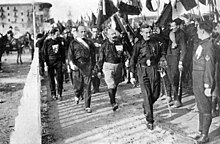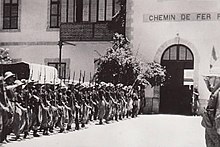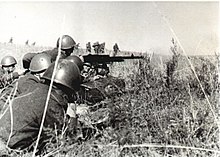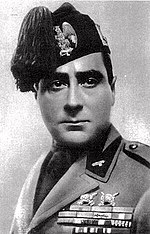Blackshirts
This article includes a list of general references, but it lacks sufficient corresponding inline citations. (June 2011) |
 MVSN insignia, helmet stencil version | |
| Paramilitary organization overview | |
|---|---|
| Formed | 23 March 1923 |
| Preceding paramilitary organization | |
| Dissolved | 8 December 1943 |
| Superseding paramilitary organization | |
| Type | Paramilitary, Gendarmerie |
| Jurisdiction | |
| Headquarters | Rome |
| Minister responsible | |
| Parent paramilitary organization | |
| Part of a series on |
| Fascism |
|---|
 |
The Milizia Volontaria per la Sicurezza Nazionale (MVSN, "Voluntary Militia for National Security"), commonly called the Blackshirts (Italian: Camicie Nere, CCNN, singular: Camicia Nera) or squadristi (singular: squadrista), was originally the paramilitary wing of the National Fascist Party, known as the Squadrismo, and after 1923 an all-volunteer militia of the Kingdom of Italy under Fascist rule, similar to the SA in Nazi Germany. Its members were distinguished by their black uniforms (modelled on those of the Arditi, Italy's elite troops of World War I) and their loyalty to Benito Mussolini, the Duce (leader) of Fascism, to whom they swore an oath. The founders of the paramilitary groups were nationalist intellectuals, former army officers and young landowners opposing peasants' and country labourers' unions. Their methods became harsher as Mussolini's power grew, and they used violence and intimidation against Mussolini's opponents.[1] In 1943, following the fall of the Fascist regime, the MVSN was integrated into the Royal Italian Army and disbanded.
History



The Blackshirts were established as the Squadrismo in 1919 and consisted of many disgruntled former soldiers. It was given the task of leading fights against their bitter enemies – the Socialists. They may have numbered 200,000 by the time of Mussolini's March on Rome from 27 to 29 October 1922. In 1922 the squadristi were reorganized into the milizia and formed numerous bandiere, and on 1 February 1923 the Blackshirts became the Voluntary Militia for National Security (Milizia Volontaria per la Sicurezza Nazionale, or MVSN), which lasted until 8 September 1943 Armistice of Cassibile. The Italian Social Republic, located in the areas of northern Italy occupied by Germany, reformed the MVSN on 8 December 1943 into the National Republican Guard (Guardia Nazionale Repubblicana, or GNR).
Organization
Benito Mussolini was the leader, or Commandant–General and First Honorary Corporal, of the Blackshirts, but executive functions were carried out by the Chief of Staff, equivalent to an army general. The MVSN was formed in imitation of the ancient Roman army, as follows:
Basic organization
The terms after the first are not words common to European armies (e.g., the Italian battaglione has cognates in many languages). Instead, they derive from the structure of the ancient Roman army.
- Zona (zone) = division
- Legione (legion) = regiment, each legion was a militia unit consisting of a small active cadre and a large reserve of civilian volunteers.
- Coorte (cohort) = battalion
- Centuria (centuria) = company
- Manipolo (maniple) = platoon
- Squadra (squad) = squad
These units were also organized on the triangular principle as follows:
- 3 squadre = 1 manipolo (maniple)
- 3 manipoli = 1 centuria (centuria)
- 3 centuriae = 1 coorte (cohort)
- 3 coorti = 1 legione (legion)
- 3 legioni = 1 divisioni (field division)
- 3 or more legioni = 1 zona (zone – an administrative division)
Territorial organization


The MVSN original organization consisted of 15 zones controlling 133 legions (one per province) of three cohorts each and one Independent Group controlling 10 legions. In 1929 it was reorganized into four raggruppamenti, but later in October 1936 it was reorganized into 14 zones controlling only 133 legions with two cohorts each, one of men 21 to 36 years old and the other of men up to 55 years old. There were also special units in Rome, on Ponza Island and the black uniformed Moschettieri del Duce ("The Leader's Musketeers", Mussolini's Guard), the Albanian Fascist Militia (four legions) and Milizia Coloniale in Africa (seven legions).
Security militia
Special militias were also organized to provide security police and gendarmerie functions, these included:
- Forestry Militia
- Frontier Militia
- Highway Militia
- Port Militia
- Posts and Telegraph Militia
- Railway Militia
- University Militia
- Anti-aircraft and Coastal Artillery Militia, a combined command which controlled two militias:
- Anti-Aircraft Militia
- Coastal Artillery Militia
Standards
The standards of each of the units of the Blackshirts, save for the Moschettieri del Duce, which carried a small standard in black similar to those of the regular armed forces, were a modernized form of the standards (Vexillum) used by the old Roman army.
Abyssinian Campaign


During the 1935–36 Second Italo-Abyssinian War against Ethiopia, seven CCNN Divisions were organized:
- 1st (23 March) CCNN Division
- 2nd (28 October) CCNN Division
- 3rd (21 April) CCNN Division
- 4th (3 January) CCNN Division
- 5th (1st Febbraio) CCNN Division
- 6th (Tevere) CCNN Division
The first six Divisions were sent to Ethiopia and participated in the war and in the Italian war crimes in Ethiopia.[2]
- 7th (Cirene) CCNN Division – The 7th CCNN Division "Cirene" was never deployed overseas or even fully equipped before it was disbanded.[3]
Division organization
Organization on 3 October 1935
- Divisional HQ
- 3 x Legions each with:
- Legion HQ
- 1 Legionary Machine Gun Company with 16 machine guns
- 2 Legionary Infantry Battalions, each with:
- 1 Machine Gun Company with 8x 8mm Breda machine guns and
- 3 Infantry Companies each with 9 light machine guns and 3x 45mm mortars
- 1 pack-artillery battery with 4x 65mm L17 each.[4]
- 1 x Artillery Battalion (Army) with 3 batteries (65/17)
- 1 x Engineers company (mixed Army and Blackshirts)
- 2 x Replacements Battalions (1 Infantry, 1 Mixed)
- 1 x Medical Section
- 1 x Logistics Section (food)
- 1 x Pack-Mules unit (1600 mules)
- 1 x Mixed Trucks unit (80 light trucks)
The Blackshirts Rifle Battalions had three rifle companies but no MMG company. The rifle companies had three platoons (three squads with one LMG each). Each Legion had a MMG company with four platoons of three weapons each (plus two spare ones). The Blackshirts replacements battalions were organized as the Blackshirts Rifle Battalions, but its platoon were overstrength (60 men each) and with only 1 x LMG in each platoon.[5]
Organization on 10 June 1940
- Division Command
- 2 Black Shirt Legions - each
- 3 Battalions
- 1 81mm Mortar Company
- 1 Accompanying Battery 65mm/17 Mtn guns
- 1 Machine Gun Battalion
- 1 Artillery Regiment:
- 2 Artillery Groups
- 1 Artillery Group
- 2 AA Batteries 20mm
- 1 Mixed Engineering Battalion
- 1 Ambulance Section Sanita
- 3 Field Hospitals (Planned when available)
- 1 Supply Section
- 1 Section Mixed Transport[6]
Leadership
Spanish Civil War
Three CCNN Divisions were sent to participate in the Spanish Civil War as part of the Corpo Truppe Volontarie. The Blackshirt (Camicie Nere, or CCNN) Divisions contained regular soldiers and volunteer militia from the Fascist Party. The CCNN divisions were semi-motorised.
- 1st CCNN Division "Dio lo Vuole" ("God Wills it")
- 2nd CCNN Division "Fiamme Nere" ("Black Flames")
- 3rd CCNN Division "Penne Nere" ("Black Feathers")
The 3rd CCNN Division was disbanded and consolidated with the 2nd CCNN Division in April 1937 after their defeat at Guadalajara. After the campaigns in Northern Spain ended in October 1937, the 2nd CCNN Division was consolidated with the 1st CCNN and renamed the XXIII de Marzo Division "Llamas Negras".
World War II

In 1940 the MVSN was able to muster 340,000 first-line combat troops, providing three divisions (1st, 2nd and 4th – all three of which were lost in the North African Campaign) and, later in 1942, a fourth division ("M") and fifth division Africa were forming.

Mussolini also pushed through plans to raise 142 MVSN combat battalions of 650 men each to provide a Gruppo di Assalto to each army division. These Gruppi consisted of two cohorts (each of three centuriae of three manipoli of two squadre each) plus Gruppo Supporto company of two heavy machine gun manipoli (with three HMG each) and two 81 mm mortar manipoli (with three Mortars each).
Later 41 Mobile groups were raised to become the third regiment in Italian Army divisions as it was determined through operational experience that the Italian army's binary divisions were too small in both manpower and heavy equipment. These mobile groups suffered heavy casualties due to being undermanned, under equipped and under trained.
In 1941, Mussolini decided to create 22 highly trained combat battalions called "M" Battalions. These battalions were given the designation M alongside their names in the Army OOB to indicate their status; that they had received specialist assault and combat training, or had proven themselves in combat and had received a battlefield promotion to this status. By the end of the Fascist regime only 11 battalions had been fully formed.
The MVSN fought in every theater where Italy did.
Appearance

The Blackshirts wore the same uniform as the Italian army with the addition of a black shirt and tie and a black fez. The uniform jacket had black flames with two ends on the collar in place of the insignia and the lictor bundles instead of the army's stars.[7] There was an all-black dress uniform worn by some officers and the Moschettieri del Duce ("The Leader's Musketeers", Mussolini's Guard).
Ranks
Mussolini as Comandante Generale was made Primo Caporale Onorario (First Honorary Corporal) in 1935 and Adolf Hitler was made Caporale Onorario (Honorary Corporal) in 1937. All other ranks closely approximated those of the old Roman army as follows.
Officers
Other Ranks
Legacy
The ethos and sometimes the uniform were later copied by others who shared Mussolini's political ideas, including Adolf Hitler in Nazi Germany, who issued brown shirts to the "Storm Troops" (Sturmabteilung) and black uniforms to the "Defense Squad" (Schutzstaffel, also colloquially known as "Brownshirts", because they wore black suit-like tunics with brown shirts), Sir Oswald Mosley in the United Kingdom (whose British Union of Fascists were also known as the "Blackshirts"), the Warriors for the Advancement of the Bulgarian National Spirit who wore red shirts, William Dudley Pelley in the United States (Silver Legion of America or "Silver Shirts"), in Mexico the Camisas Doradas or "Golden Shirts", Plínio Salgado in Brazil (whose followers wore green shirts), and Eoin O'Duffy in the Irish Free State (Army Comrades Association or "Blueshirts"). "Blueshirts" can also refer to Canadian fascists belonging to the Canadian National Socialist Unity Party and to the members of Falange Española, the most influential party within Franco's dictatorship in Spain. The paramilitary fascist Iron Guard members in Romania and the fascist Yugoslav Radical Union wore green shirts.
After the Armistice of Cassibile was signed, the Blackshirts were dissolved; in the pro-fascist Italian Social Republic they were replaced by the National Republican Guard and the Black Brigades in the militia role, alongside the Republican Police Corps.
See also
- Blackshirts – Albania
- Redshirts – Bulgaria
- Blueshirts – Canada
- Blue Shirts – China (Kuomintang)
- Brownshirts – Nazi Germany
- Blackshirts – Nazi Germany
- Gestapo – Nazi Germany
- Blueshirts – Ireland
- Greenshirts – Ireland
- Greenshirts – United Kingdom
- Greenshirts – Yugoslavia
- Greenshirts – Brazil
- Redshirts – Italy
- Redshirts – Mexico
- Goldshirts – Mexico
- Greyshirts – ethnically Dutch South Africans
- Greenshirts – Romania
- Blackshirts – United Kingdom
- Silvershirts – United States
- Black Brigades
- Italian Social Republic
- Portuguese Legion
- Yokusan Sonendan – Japan
General
- Militia
- Paramilitary
- Political color
- Political uniform
- Squadrismo
- Integralismo
- Black Shorts – parody of the blackshirts in the writings of P.G. Wodehouse
Notes
- ^ Bosworth, R. J. B, Mussolini's Italy: Life Under the Fascist Dictatorship, 1915–1945 (Penguin Books, 2005), p. 117
- ^ Del Boca, Angelo. Il gas di Mussolini. Il fascismo e la guerra d'Etiopia.
- ^ The Blackshirt Division Order of Battle comes from "Storia delle Unità Combattenti della MVSN 1923-1943" by Ettore Lucas and Giorgio de Vecchi, Giovanni Volpe Editore 1976 pages 63 to 116 plus errata.
- ^ Italian Army Infantry Regulation of 1939 (Page 472/473)I
- ^ The Blackshirts Division TO&E comes from an original document (order sheet "Ministero della Guerra, Comando del Corpo di Stato Maggiore - Ufficio Ordinamento e Mobilitazione . Prot.2076 del 18-06-1935").
- ^ The Blackshirts Division TO&E comes from an original document (order sheet "Ministero della Guerra, Comando del Corpo di Stato Maggiore - Ufficio Ordinamento e Mobilitazione. dated 1939").
- ^ http://www.regioesercito.it/uniformi/unimilizia35.htm



















